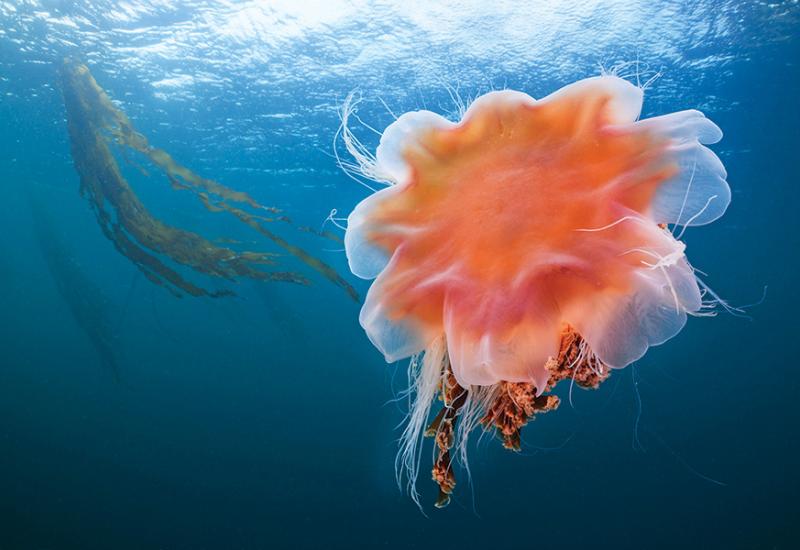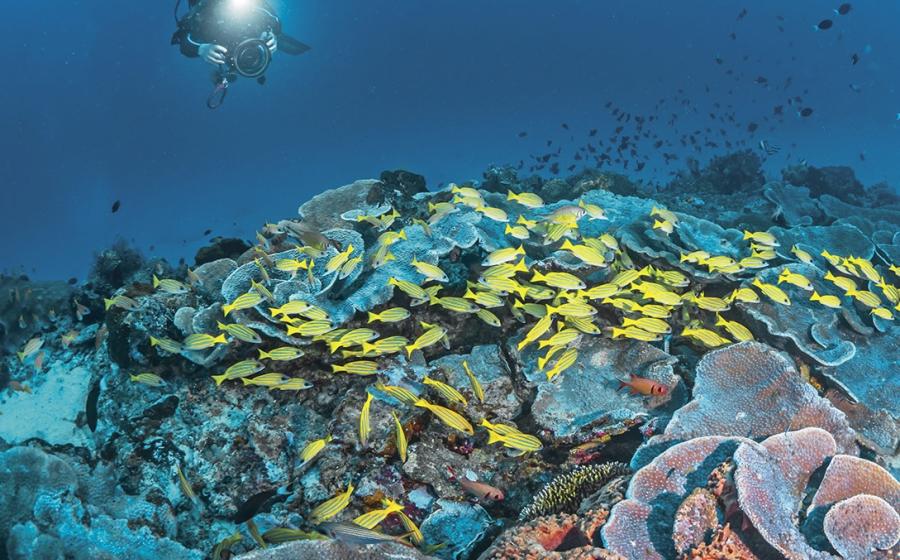At Play in the Florida Swamps: Diving Peacock Springs
Peering down at the surface of Orange Grove Sink, you might wonder why anyone would ever consider taking a leap of faith into the primordial soup of this north Florida swampland. On a good day you have to reckon with the messy green duckweed; on others, you have to do it eye to eye with a menacing alligator.
Before the entry steps were built, I would jokingly add to the predive stress by telling first-timers they’d have to make a giant stride leap off the edge of the sheer 15-foot limestone cliff. After the gasps of horror and nervous laughter subsided, I’d point out the muddy path painstakingly worn between the rocks and cypress tree roots. These days, an overbuilt stair-and-ramp structure makes the entry safe and easy, but the peering eyes of the toothy reptile on the far side of the pond guarantee tension still hangs in the air.
Orange Grove Sink is one of two major springs in Wes Skiles Peacock Springs State Park — which boasts an additional nine sinkholes and springs, and a long slough, meandering down to the famed Suwannee River. With over 38,000 feet of explored passage, Peacock offers divers the chance to explore one of the longest underwater cave systems in the United States.
In 1875, Dr. John Calvin Peacock purchased the property, where he raised cattle and religious fervor in church services held in his home. This tract of land, located within the buckle of the southern Bible Belt, boasts an early connection with Christianity and missionary work. One spring, appropriately named Baptizing Spring, was the site of a Timmucuan Indian village, and later a thriving Spanish mission. Natives and immigrants were dunked in the clear water as they pledged their life to Christ.
The Nature Conservancy purchased Peacock’s 250-acre ranch to create the park, and in 2006 the Trust for Public Land expanded the territory to encompass an additional 481 acres. In 2011, the park name was appended, to honor the late Wes Skiles, a cave-diving filmmaker and springs’ advocate who worked tirelessly to protect Florida’s water resources.
Descending through the duckweed, I pause for a moment to marvel at the cloud of minnows consuming the tiny green leaves and hairlike roots floating on the surface. A veil of green confetti rains down to the depths, catching the beams of light penetrating through the swampy mess above.
My buddy Alex hacks through his second stage, dislodging the weedy protein from the exhaust valve before tying his primary reel to a twisted tangle of tree roots. Above us, the white belly of the alligator lingers on the edge of the sink. Alex takes one last look before spooling out his line into the cave. Below us, the Lower Orange Grove cavern yields to a 180-foot-deep cave passage, accessible only to sidemounters. Today, we’re attempting the Grand Traverse, and we hope to finish our dive at Peacock One, some 4,671 feet away through the mazelike system.
Entering the Upper Orange Grove Tunnel we pass a memorial stone, placed to remember a team of divers that did not make it out of the cave. To ensure divers are aware of the danger, a brightly colored National Association of Cave Divers stop sign warns cavern and other divers not to proceed beyond this point.
The clear water is incredibly alluring to an untrained eye. Although the annual number of cave-diving accidents has decreased over the years, the leading cause of fatalities is still due to divers going beyond their level of training and experience — more than 600 people have perished in caves around the world, and this site is no stranger to tragedy. As recently as last year, a woman with entry-level, partial cave training died attempting a complex dive plan that was beyond her background and abilities. Caves can be deceptively easy places to enter and decidedly easy places to die — they carry no bias for age, gender or lengthy dive logs, and the best prevention is good training and solid experience, with a careful eye to good risk management.
It’s 1 p.m. and Alex and I are on our second dive of the day. When the park opened at 8 a.m., we were first to splash in at Peacock One. The underwater amphitheater displays its finest visual glory before anyone has stirred up the silty floor, and we wasted no time putting in a primary reel and heading down the Main Line in the direction of Pothole Sink. Other divers slipped in beside us and sprinted for the popular Peanut Tunnel line with their instructor, preparing for lights-out drills that would reduce the visibility, similar to what we would experience later in the day. Our morning goal was to complete a setup dive. We placed our reel and kicked upstream as far as our “thirds” would take us. Tagging the line with a nondirectional distance marker called a “cookie,” we retreated after an arduous two-hour profile that left our bellies screaming for food.
Lunch at the Luraville Country Store is not just a meal break, it’s a visit with cave diving history and a chance to review the large cave map shellacked to the eight-foot wooden cafe table. The place is a hangout, not just for post-dive exaltations but also for local coffee-drinking philosphers and dusty, itinerant farm workers. On the wall, archival photos of past floods and other mementos of Old Florida history hang over racks containing Spanish tabloids, chewing tobacco and Slim Jims. The resulting blend of cultures and confections give the store a unique funk factor that makes it memorable and special.
Our morning setup served as a safety net to ensure that we would have enough gas in our tanks to complete the through trip from Orange Grove to Peacock. As long as we reach our cookie before we’ve used one-third of our air supply, we’ll know we can make the trip within safe reserves. We set off down the meandering tunnel and leave the daylight of Orange Grove Sink behind us.
The slight upstream flow is bringing cobalt-blue water from the spring shed to the north. We pass by Distance Tunnel and continue toward Challenge Sink, an opening that offers some extra comfort for my understudy on his first traverse. At Woody’s Tunnel, the flow picks up, and we’re now being gently nudged toward Challenge Sink downstream. The line sneaks up to peek at the surface through a stunning karst window at the bottom of the limestone sink.
Challenge Sink lies in the verdant woods across the road from the main entrance to the park. It’s the only sink in the system that strays off the parklands. Aptly named, the opening serves only as an emergency exit. For this reason, the next part of the cave is perhaps the most remote and least dived. The low winding tunnels from Orange Grove open up to cathedral-size galleries of pristine scalloped rock. Diving in this section, I feel a special buzz of anticipation. I wonder whether Alex can make it to the cookie without breaking his thirds. Knowing we have another 200 feet to go, I signal to give him a chance to abort. He replies with an OK and we swim on.
When first-time divers attempt the Grand Traverse, nerves sometimes eat up a little gas, but my buddy seems to have made it, reaching the cookie with about 150 psi to spare. I can see the relief in his eyes. The rest of the trip will be downstream and through familiar territory. Passing through Olsen and Pothole sinks, we finally emerge at Peacock One, 117 minutes after entering Orange Grove Sink.
Peacock One is a hive of activity today, with cave students and instructors reviewing their dives. We hitch a ride back to my van, bouncing on the tailgate of a pickup down the sandy-pitted roads. Alex is grinning from ear to ear, feeling the joy of accomplishing a swimming distance that few people even walk. He’s finned more than 1.5 miles in one day and is ready to crash hard.
We arrive at the parking lot and he starts to take off his double tanks on a picnic table when I remind him we have one last task. We need to retrieve our primary reel from Orange Grove Sink. He laughs as we walk down the steps to the sink and reach the water’s edge. Our grinning reptilian friend has decided to warm himself in the late afternoon sun, perched on a cypress log, displaying his six-foot splendor, a watchful guardian of Orange Grove Sink.
Need to Know
When to Go The park is open year round from 8 a.m. until sunset, but divers must begin their final dive of the day prior to the time posted at the entrance to the park. Strict out-of-the-water-times must be adhered to. Weekends attract the largest crowds, rarely resulting in poor diving conditions.
Dive Conditions Water temps remain stable at 70 to 72 F degrees inside the cave, with visibility in the 60- to 100-foot range. Summer algal blooms sometimes obscure visibility in the open-water entrance pools and Orange Grove Sink. At those times, open-water diving is not recommended.
Operators It’s easier to get a mixed-gas fill than a hot meal in the neighborhood of Peacock Springs. Minutes from the park, Luraville is a quaint country crossroads, featuring a humble general store and two world-class dive centers. The Dive Outpost (diveoutpost.com) and Cave Excursions (caveexcursions.com) are full-service dive shops offering state-of-the-art fill stations, merchandise, instruction and lodging.
Price Tag An entry fee of $4 is paid by cash through an honor box. Divers must display their certification cards on their dashboard for park rangers to view as they drive through the park during the day. Nitrox and oxygen are priced very inexpensively and sold by volume. Lodging ranges from $25 bunk-room facilities to shared trailers under $100 per night.
What It Takes
Open-water diving is available in the spacious sink at Orange Grove, but to truly appreciate the wonders of the park divers should enroll in Cavern and Cave Diver training from a reputable agency instructor. Cavern divers must stay within the daylight zone of Orange Grove, Peacock One and Peacock Three Sinks. This zone of visibility can become very limited during busy weekends. Full Cave diver training requires roughly seven to eight days and may be broken into smaller segments to enhance learning and experience. Divers attempting the Grand Traverse from Orange Grove to Peacock One should have adequate experience beyond Full Cave Diver qualification and should properly set up their dive from Peacock One prior to attempting the through trip. Detailed cave maps are posted at parking lots throughout the park and guided dives may be arranged through local dive shops. Main passages within Peacock bear a maximum depth of 60 feet with some deeper technical dives available at Lower Orange Grove and Peacock 3 entrances.
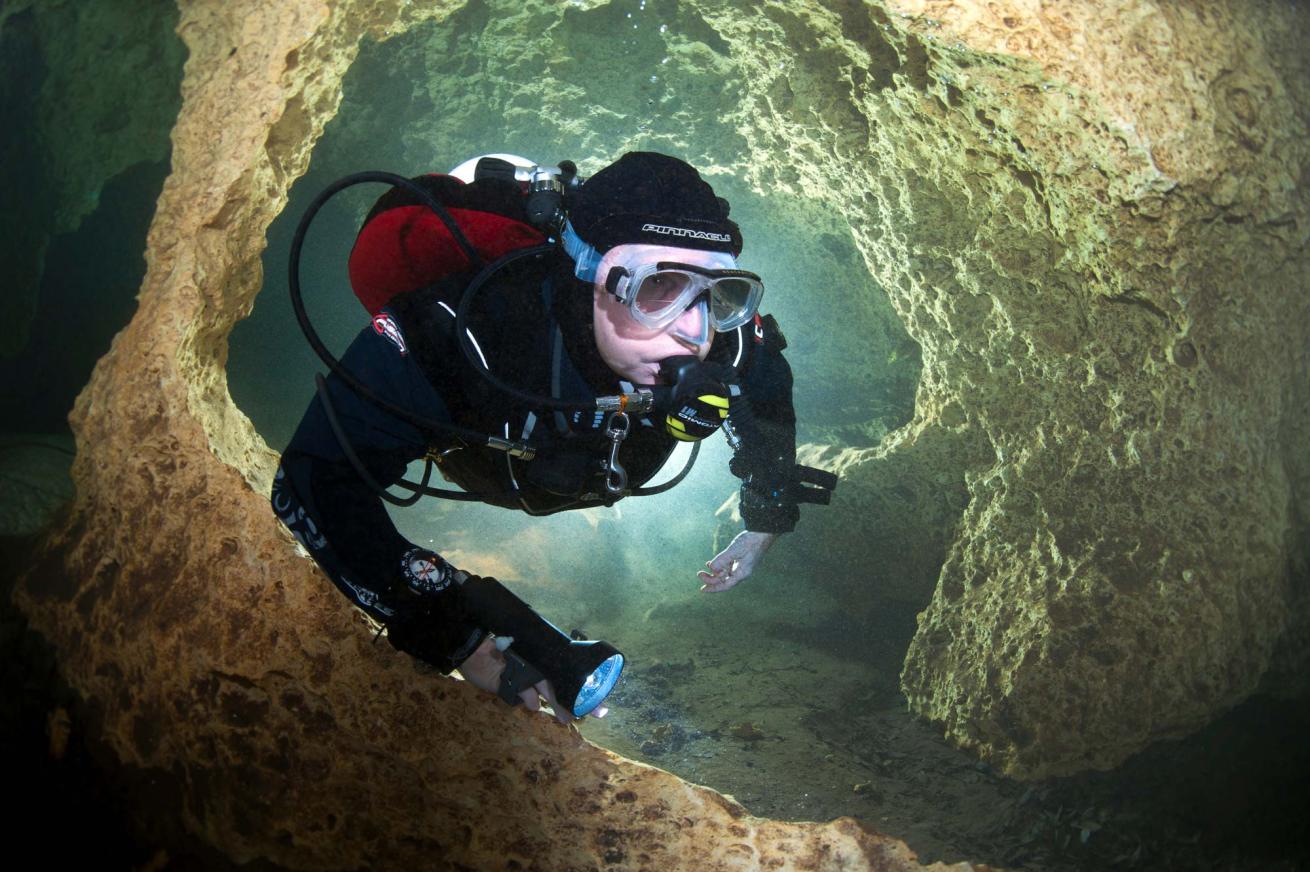
Jill Heinerth

Jill HeinerthSteps lead down to the water at Orange Grove Sink, where divers' bubbles have cleared a hole in the duckweed.
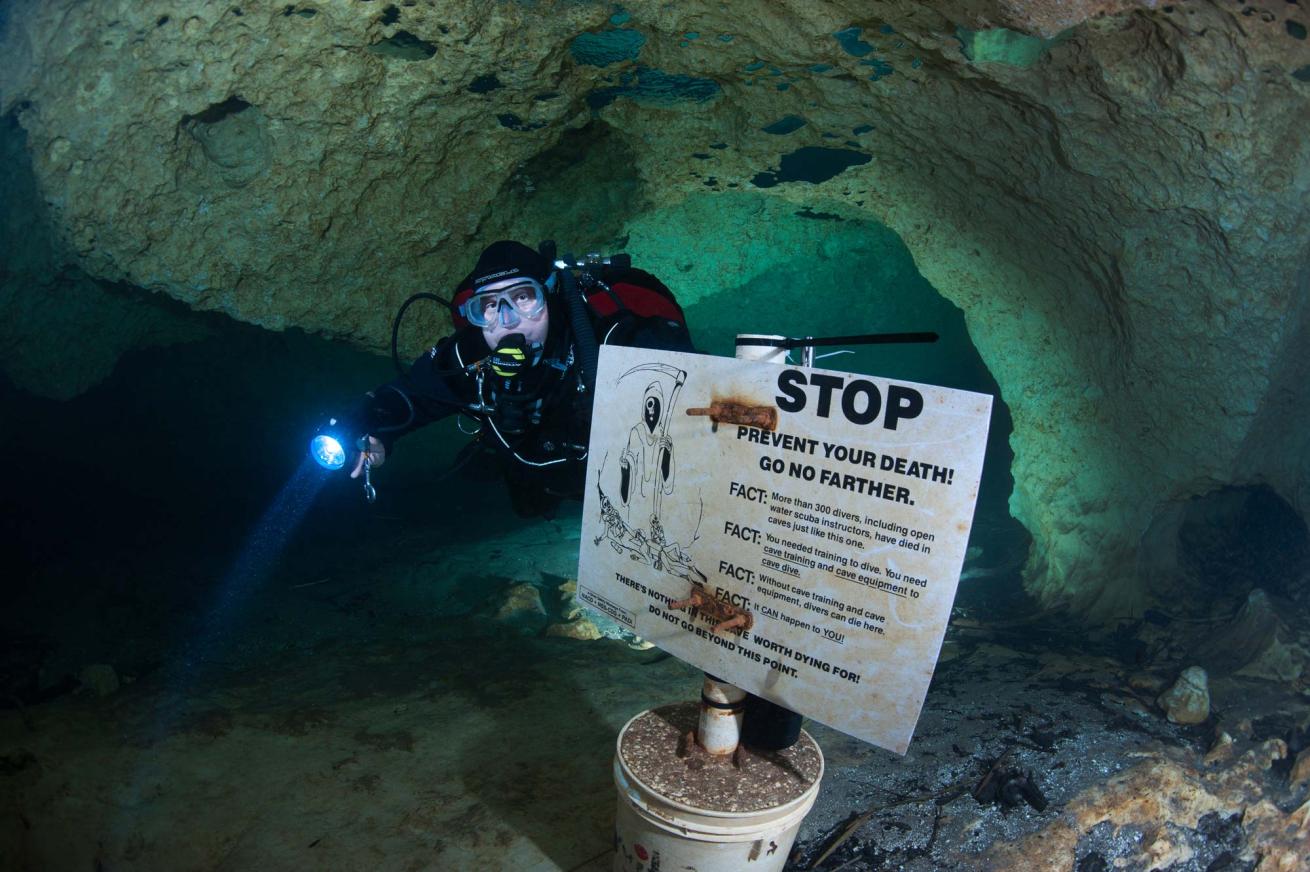
Jill HeinerthThe warning sign installed at the limits of the daylight zone inside Peacock Springs.
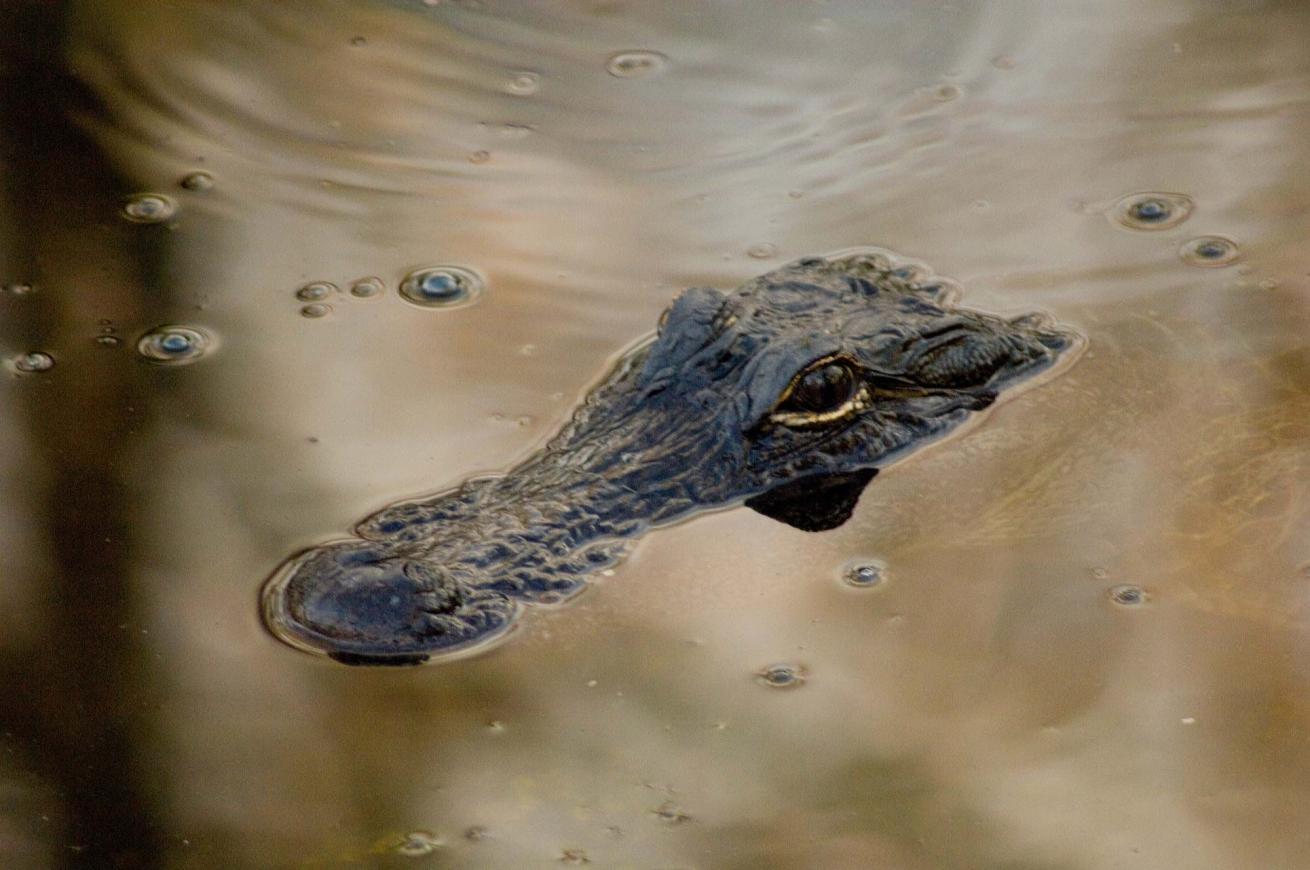
Jill Heinerth

Jill HeinerthTying the primary reel on a fallen tree inside Orange Grove Sink before heading downstream on the Grand Traverse.
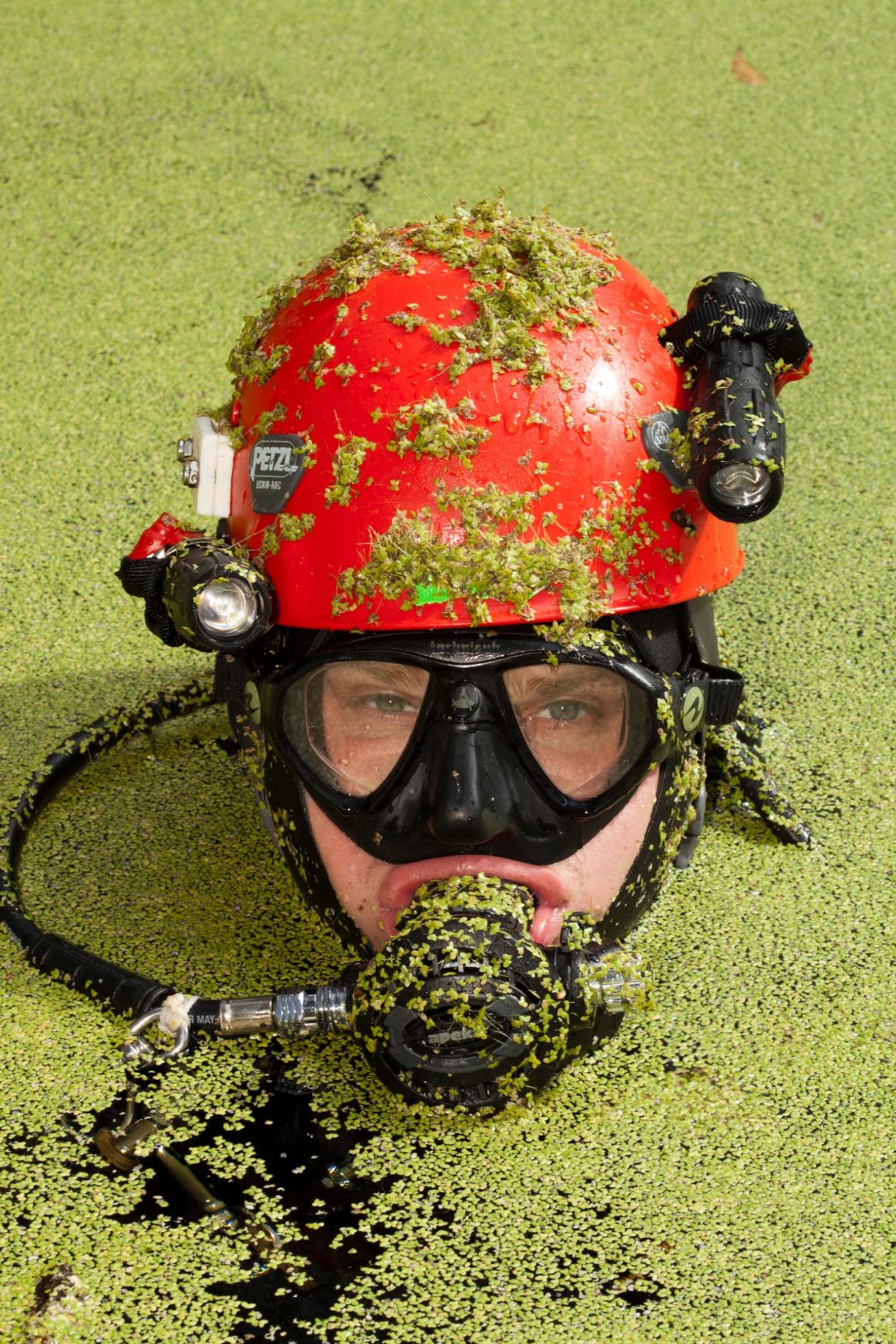
Jill HeinerthHanging in the duckweed that coats the surface of the springs.
Peering down at the surface of Orange Grove Sink, you might wonder why anyone would ever consider taking a leap of faith into the primordial soup of this north Florida swampland. On a good day you have to reckon with the messy green duckweed; on others, you have to do it eye to eye with a menacing alligator.
Before the entry steps were built, I would jokingly add to the predive stress by telling first-timers they’d have to make a giant stride leap off the edge of the sheer 15-foot limestone cliff. After the gasps of horror and nervous laughter subsided, I’d point out the muddy path painstakingly worn between the rocks and cypress tree roots. These days, an overbuilt stair-and-ramp structure makes the entry safe and easy, but the peering eyes of the toothy reptile on the far side of the pond guarantee tension still hangs in the air.
Orange Grove Sink is one of two major springs in Wes Skiles Peacock Springs State Park — which boasts an additional nine sinkholes and springs, and a long slough, meandering down to the famed Suwannee River. With over 38,000 feet of explored passage, Peacock offers divers the chance to explore one of the longest underwater cave systems in the United States.
In 1875, Dr. John Calvin Peacock purchased the property, where he raised cattle and religious fervor in church services held in his home. This tract of land, located within the buckle of the southern Bible Belt, boasts an early connection with Christianity and missionary work. One spring, appropriately named Baptizing Spring, was the site of a Timmucuan Indian village, and later a thriving Spanish mission. Natives and immigrants were dunked in the clear water as they pledged their life to Christ.
The Nature Conservancy purchased Peacock’s 250-acre ranch to create the park, and in 2006 the Trust for Public Land expanded the territory to encompass an additional 481 acres. In 2011, the park name was appended, to honor the late Wes Skiles, a cave-diving filmmaker and springs’ advocate who worked tirelessly to protect Florida’s water resources.
Descending through the duckweed, I pause for a moment to marvel at the cloud of minnows consuming the tiny green leaves and hairlike roots floating on the surface. A veil of green confetti rains down to the depths, catching the beams of light penetrating through the swampy mess above.
My buddy Alex hacks through his second stage, dislodging the weedy protein from the exhaust valve before tying his primary reel to a twisted tangle of tree roots. Above us, the white belly of the alligator lingers on the edge of the sink. Alex takes one last look before spooling out his line into the cave. Below us, the Lower Orange Grove cavern yields to a 180-foot-deep cave passage, accessible only to sidemounters. Today, we’re attempting the Grand Traverse, and we hope to finish our dive at Peacock One, some 4,671 feet away through the mazelike system.
Entering the Upper Orange Grove Tunnel we pass a memorial stone, placed to remember a team of divers that did not make it out of the cave. To ensure divers are aware of the danger, a brightly colored National Association of Cave Divers stop sign warns cavern and other divers not to proceed beyond this point.
The clear water is incredibly alluring to an untrained eye. Although the annual number of cave-diving accidents has decreased over the years, the leading cause of fatalities is still due to divers going beyond their level of training and experience — more than 600 people have perished in caves around the world, and this site is no stranger to tragedy. As recently as last year, a woman with entry-level, partial cave training died attempting a complex dive plan that was beyond her background and abilities. Caves can be deceptively easy places to enter and decidedly easy places to die — they carry no bias for age, gender or lengthy dive logs, and the best prevention is good training and solid experience, with a careful eye to good risk management.
It’s 1 p.m. and Alex and I are on our second dive of the day. When the park opened at 8 a.m., we were first to splash in at Peacock One. The underwater amphitheater displays its finest visual glory before anyone has stirred up the silty floor, and we wasted no time putting in a primary reel and heading down the Main Line in the direction of Pothole Sink. Other divers slipped in beside us and sprinted for the popular Peanut Tunnel line with their instructor, preparing for lights-out drills that would reduce the visibility, similar to what we would experience later in the day. Our morning goal was to complete a setup dive. We placed our reel and kicked upstream as far as our “thirds” would take us. Tagging the line with a nondirectional distance marker called a “cookie,” we retreated after an arduous two-hour profile that left our bellies screaming for food.
Lunch at the Luraville Country Store is not just a meal break, it’s a visit with cave diving history and a chance to review the large cave map shellacked to the eight-foot wooden cafe table. The place is a hangout, not just for post-dive exaltations but also for local coffee-drinking philosphers and dusty, itinerant farm workers. On the wall, archival photos of past floods and other mementos of Old Florida history hang over racks containing Spanish tabloids, chewing tobacco and Slim Jims. The resulting blend of cultures and confections give the store a unique funk factor that makes it memorable and special.
Our morning setup served as a safety net to ensure that we would have enough gas in our tanks to complete the through trip from Orange Grove to Peacock. As long as we reach our cookie before we’ve used one-third of our air supply, we’ll know we can make the trip within safe reserves. We set off down the meandering tunnel and leave the daylight of Orange Grove Sink behind us.
The slight upstream flow is bringing cobalt-blue water from the spring shed to the north. We pass by Distance Tunnel and continue toward Challenge Sink, an opening that offers some extra comfort for my understudy on his first traverse. At Woody’s Tunnel, the flow picks up, and we’re now being gently nudged toward Challenge Sink downstream. The line sneaks up to peek at the surface through a stunning karst window at the bottom of the limestone sink.
Challenge Sink lies in the verdant woods across the road from the main entrance to the park. It’s the only sink in the system that strays off the parklands. Aptly named, the opening serves only as an emergency exit. For this reason, the next part of the cave is perhaps the most remote and least dived. The low winding tunnels from Orange Grove open up to cathedral-size galleries of pristine scalloped rock. Diving in this section, I feel a special buzz of anticipation. I wonder whether Alex can make it to the cookie without breaking his thirds. Knowing we have another 200 feet to go, I signal to give him a chance to abort. He replies with an OK and we swim on.
When first-time divers attempt the Grand Traverse, nerves sometimes eat up a little gas, but my buddy seems to have made it, reaching the cookie with about 150 psi to spare. I can see the relief in his eyes. The rest of the trip will be downstream and through familiar territory. Passing through Olsen and Pothole sinks, we finally emerge at Peacock One, 117 minutes after entering Orange Grove Sink.
Peacock One is a hive of activity today, with cave students and instructors reviewing their dives. We hitch a ride back to my van, bouncing on the tailgate of a pickup down the sandy-pitted roads. Alex is grinning from ear to ear, feeling the joy of accomplishing a swimming distance that few people even walk. He’s finned more than 1.5 miles in one day and is ready to crash hard.
We arrive at the parking lot and he starts to take off his double tanks on a picnic table when I remind him we have one last task. We need to retrieve our primary reel from Orange Grove Sink. He laughs as we walk down the steps to the sink and reach the water’s edge. Our grinning reptilian friend has decided to warm himself in the late afternoon sun, perched on a cypress log, displaying his six-foot splendor, a watchful guardian of Orange Grove Sink.
Need to Know
When to Go The park is open year round from 8 a.m. until sunset, but divers must begin their final dive of the day prior to the time posted at the entrance to the park. Strict out-of-the-water-times must be adhered to. Weekends attract the largest crowds, rarely resulting in poor diving conditions.
Dive Conditions Water temps remain stable at 70 to 72 F degrees inside the cave, with visibility in the 60- to 100-foot range. Summer algal blooms sometimes obscure visibility in the open-water entrance pools and Orange Grove Sink. At those times, open-water diving is not recommended.
Operators It’s easier to get a mixed-gas fill than a hot meal in the neighborhood of Peacock Springs. Minutes from the park, Luraville is a quaint country crossroads, featuring a humble general store and two world-class dive centers. The Dive Outpost (diveoutpost.com) and Cave Excursions (caveexcursions.com) are full-service dive shops offering state-of-the-art fill stations, merchandise, instruction and lodging.
Price Tag An entry fee of $4 is paid by cash through an honor box. Divers must display their certification cards on their dashboard for park rangers to view as they drive through the park during the day. Nitrox and oxygen are priced very inexpensively and sold by volume. Lodging ranges from $25 bunk-room facilities to shared trailers under $100 per night.
What It Takes
Open-water diving is available in the spacious sink at Orange Grove, but to truly appreciate the wonders of the park divers should enroll in Cavern and Cave Diver training from a reputable agency instructor. Cavern divers must stay within the daylight zone of Orange Grove, Peacock One and Peacock Three Sinks. This zone of visibility can become very limited during busy weekends. Full Cave diver training requires roughly seven to eight days and may be broken into smaller segments to enhance learning and experience. Divers attempting the Grand Traverse from Orange Grove to Peacock One should have adequate experience beyond Full Cave Diver qualification and should properly set up their dive from Peacock One prior to attempting the through trip. Detailed cave maps are posted at parking lots throughout the park and guided dives may be arranged through local dive shops. Main passages within Peacock bear a maximum depth of 60 feet with some deeper technical dives available at Lower Orange Grove and Peacock 3 entrances.

